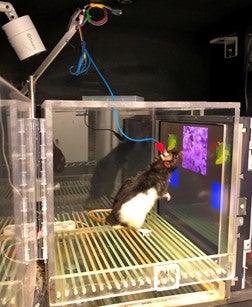By Brian Kangas, Bill Carlezon, and Diego Pizzagalli

Pictured here is a rat engaging in our touchscreen-based flanker task of cognitive control. The subject is trained to respond on one of two blue response boxes depending on the photograph (target stimulus) presented in the center of the screen. However, on select trials, the target stimulus is flanked on the left and right with stimuli that are either congruent or, in the case of this trial, incongruent with the target stimulus. The flanker stimuli are presented immediately before the target stimulus appears, leading to a natural inclination to respond to those stimuli (a prepotent response). The construct of cognitive control is measured by the subject’s ability to suppress the (incorrect) prepotent response elicited by incongruent flanker stimuli.
Developing improved treatment options for neuropsychiatric illness has been challenging. Although there are a variety of reasons for this, we believe improving crosstalk between the clinical and animal laboratory can lead to innovative research strategies and enhance therapeutics development. That is, it can often be difficult to compare outcomes from human studies with those from animal experiments due to differences in the techniques used to examine behavior and brain. Therefore, in an attempt to better align psychiatry and neuroscience, our work has focused on coordinated development of bidirectional cognitive tasks with concurrent electrophysiology techniques. We use a reverse translation strategy that identifies key aspects in human experiments and incorporates them into animal studies. This allows us to measure parallel aspects of behavior and neural activity in both clinical patient populations and laboratory animals.
In this paper we report our use of touch-sensitive technology to develop a rodent flanker task that was reverse-translated from a clinical test of cognitive control commonly used to identify attentional deficits in mood disorders. Although the rat has notoriously poor vision, we show how careful selection of visual stimuli, informed by rodent vision physiology and further optimized via behavioral testing, can produce highly similar task performance as observed in human participants. The translational value of our testing platform was enhanced by subsequent incorporation of electrophysiological recording abilities, including electroencephalogram (EEG) measures highly similar to those commonly used in human studies of cognitive control. We verified that the optimized procedure produced prototypical neural signatures associated with task outcomes, including similar responses to the presentation of visual stimuli across different electrode types. Taken together, it is highly encouraging that touchscreen-based cognitive tasks and electrophysiological recordings can be effectively used in rodents as in humans. Advancements of this sort will allow for further development of the novel and innovative research programs needed for coordinated cross-species preclinical therapeutic development.
Brian Kangas is an Assistant Professor of Psychiatry at Harvard Medical School and Director of the Cognition Biology Laboratory at McLean Hospital.
Bill Carlezon is a Professor of Psychiatry at Harvard Medical School and Director of the Behavioral Genetics Laboratory at McLean Hospital.
Diego Pizzagalli is a Professor of Psychiatry at Harvard Medical School and Director of the Center for Depression, Anxiety, and Stress Research at McLean Hospital.
Learn more in the original research article:
Concurrent electrophysiological recording and cognitive testing in a rodent touchscreen environment.
Kangas BD, Iturra-Mena AM, Robble MA, Luc OT, Potter D, Nickels S, Bergman J, Carlezon WA Jr, Pizzagalli DA. Sci Rep. 2021 Jun 3;11(1):11665. doi: 10.1038/s41598-021-91091-9. PMID: 34083596; PMCID: PMC8175731.
News Types: Community Stories
